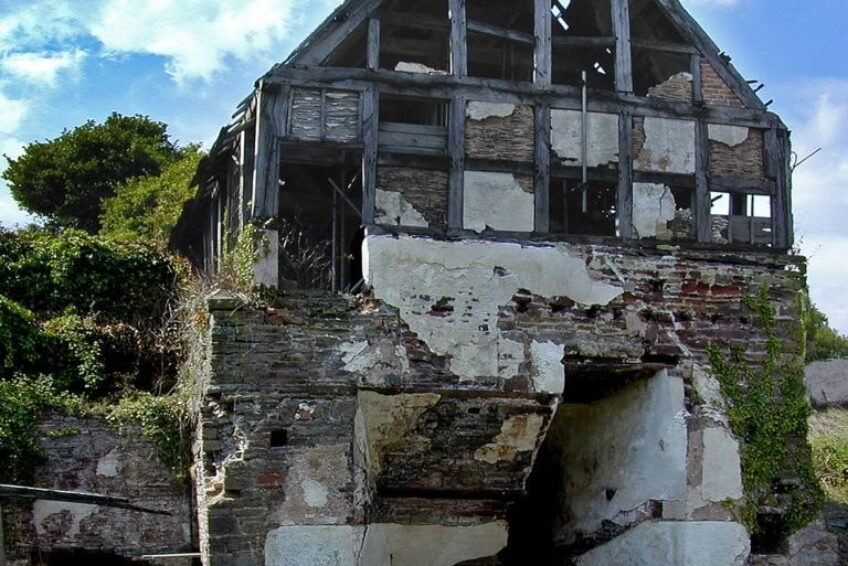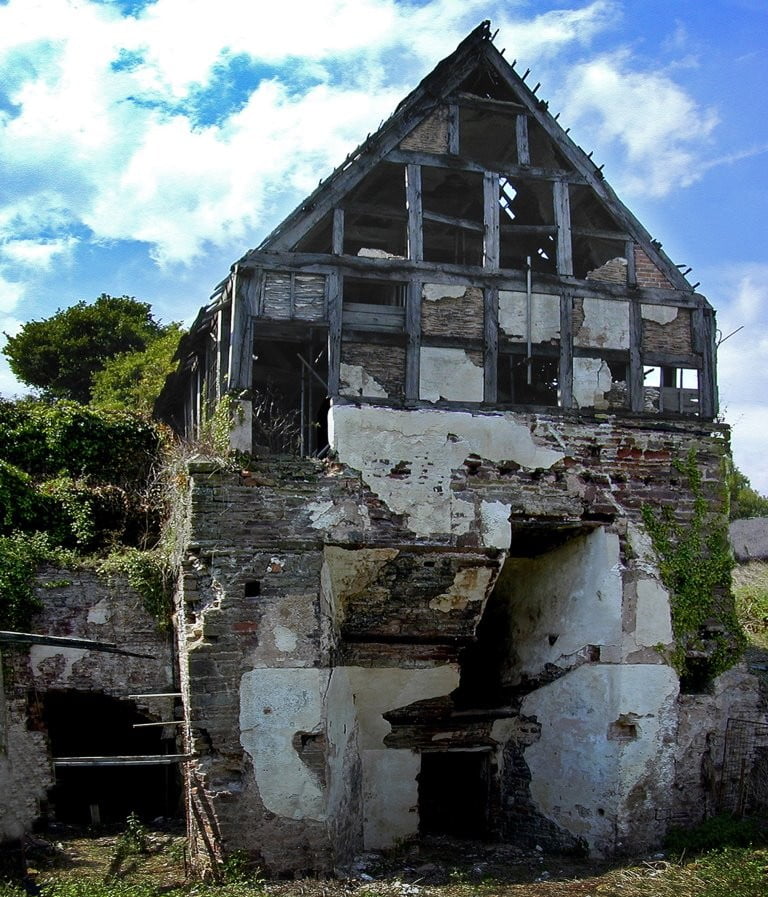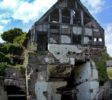
Gunn’s Mills one of the most important surviving historic sites of the British iron industry!
It is a 17th Century Blast Furnace.
The standing remains of Gunn’s Mills represent a rare example of the first generation of blast furnaces in Britain. Its level of preservation is superb and comparable to Rockley in South Yorkshire. It was a charcoal-fueled beast and inextricably linked to the Winter and Foley families; who were the most prominent industrialists in the Forest of Dean.
The buildings represent the layout of the 18th century effort, but they are build upon the earlier, 17th century remains.
Gunn’s Mills was the location of a succession of water-powered industries and some remains of an early paper mill are still there too. The ironworks were established c1625 by Sir John Winter and initially consisted of a single blast furnace.
In 1701 it was purchased by the Foley family and finally blown out in the 1730s. It was in 1738 that the site was leased to the paper-maker, Joseph Lloyd.
A high temperature in the blast furnace was maintained by a pair of bellows, housed in a separate structure built against the west side of the furnace. The bellows house and the adjacent waterwheel pit have both survived, in part!
Gunn’s Mills encompasses not just the era of charcoal smelting, but also the era of water power. By the late 18th century, most new blast furnaces were blown by steam power instead.
The early mill needed a charging house – to store the raw materials (especially important with charcoal) and it needed a casting house – so that molten iron could remain dry when the furnace was tapped and the iron was cast.
In the 19th century blast furnaces were mostly built as freestanding structures, without a charging or sometmes even a casting house!
Other similar ironworks include Flaxley, Trelech, Llandogo in the Wye Valley and Abbey Tintern.
Ironworking in Britain actually emerged from the Weald in 1496, however there are no archaeological remains found so far. Those build in the 16th century also elude us. Gunn’s Mills therefore is a bit of a treat!
It is a grade II* listed building and cared for by the Forest of Dean Buildings Preservation Trust (FODBPT).
Read all about it – HERE!
See the FODBPT gallery of images – HERE!
The dendro-dating of the oak timbers has increased the historic value of the site from important to unique but the building has been deteriorating for many years. After 2000 Gunn’s Mill Furnace was shrouded in white weatherproof plastic and continued to deteriorate, albeit at a slower rate. It is high on Historic England’s Monuments at Risk Register. In 2013, the site was donated to the Trust by Mr William Parker who purchased it a decade earlier to prevent its loss by redevelopment.
Plans are to raise the funding needed to preserve the monument and its historic detail and to equip the site with a means to sustain the monument for the long term future – help if you can!
Read the full Statement of Significance produced for the FODBPT by Cotswold Archaeology – HERE!
Lower Spout Lane, Mitcheldean Forest of Dean, Gloucestershire, GL17 0EA
Grid Reference: SO 67516 15945

Gunn’s Mills one of the most important surviving historic sites of the British iron industry!
It is a 17th Century Blast Furnace.
The standing remains of Gunn’s Mills represent a rare example of the first generation of blast furnaces in Britain. Its level of preservation is superb and comparable to Rockley in South Yorkshire. It was a charcoal-fueled beast and inextricably linked to the Winter and Foley families; who were the most prominent industrialists in the Forest of Dean.
The buildings represent the layout of the 18th century effort, but they are build upon the earlier, 17th century remains.
Gunn’s Mills was the location of a succession of water-powered industries and some remains of an early paper mill are still there too. The ironworks were established c1625 by Sir John Winter and initially consisted of a single blast furnace.
In 1701 it was purchased by the Foley family and finally blown out in the 1730s. It was in 1738 that the site was leased to the paper-maker, Joseph Lloyd.
A high temperature in the blast furnace was maintained by a pair of bellows, housed in a separate structure built against the west side of the furnace. The bellows house and the adjacent waterwheel pit have both survived, in part!
Gunn’s Mills encompasses not just the era of charcoal smelting, but also the era of water power. By the late 18th century, most new blast furnaces were blown by steam power instead.
The early mill needed a charging house – to store the raw materials (especially important with charcoal) and it needed a casting house – so that molten iron could remain dry when the furnace was tapped and the iron was cast.
In the 19th century blast furnaces were mostly built as freestanding structures, without a charging or sometmes even a casting house!
Other similar ironworks include Flaxley, Trelech, Llandogo in the Wye Valley and Abbey Tintern.
Ironworking in Britain actually emerged from the Weald in 1496, however there are no archaeological remains found so far. Those build in the 16th century also elude us. Gunn’s Mills therefore is a bit of a treat!
It is a grade II* listed building and cared for by the Forest of Dean Buildings Preservation Trust (FODBPT).
Read all about it – HERE!
See the FODBPT gallery of images – HERE!
The dendro-dating of the oak timbers has increased the historic value of the site from important to unique but the building has been deteriorating for many years. After 2000 Gunn’s Mill Furnace was shrouded in white weatherproof plastic and continued to deteriorate, albeit at a slower rate. It is high on Historic England’s Monuments at Risk Register. In 2013, the site was donated to the Trust by Mr William Parker who purchased it a decade earlier to prevent its loss by redevelopment.
Plans are to raise the funding needed to preserve the monument and its historic detail and to equip the site with a means to sustain the monument for the long term future – help if you can!
Read the full Statement of Significance produced for the FODBPT by Cotswold Archaeology – HERE!
Lower Spout Lane, Mitcheldean Forest of Dean, Gloucestershire, GL17 0EA
Grid Reference: SO 67516 15945

